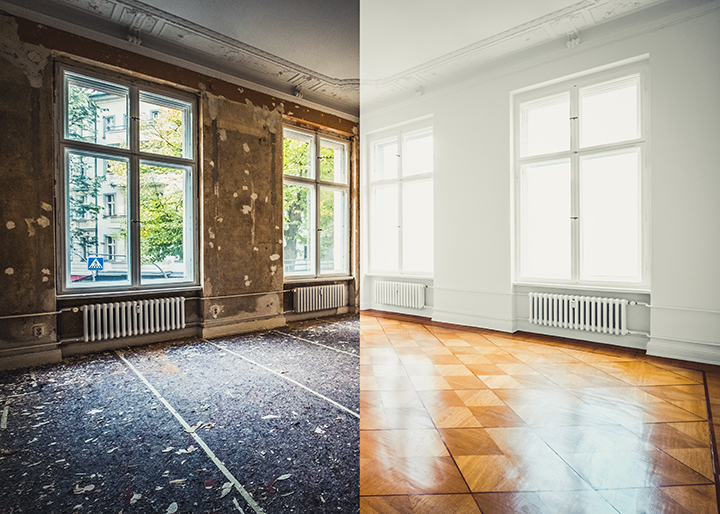Fix-and-Flip Appraisals

Understanding the Process is Key to Success
By Mark Cassidy
With its latest acquisition of Nationwide Title Clearing, Covius has completed its third successful strategic acquisition in the past three years. Being part of such a diverse group of experts is both exciting and beneficial, with expertise across the mortgage lifecycle that benefits our clients and our industry. NTC’s capital markets solutions help mitigate risk post-closing while our Service 1st valuation solutions help lenders, and fix-and-flip investors, manage risk for an asset that is in transition. It behooves these investors to understand what lenders expect to see in fix-and-flip valuations.
When qualifying a borrower for a traditional mortgage, a typical lender will focus on some combination of the 4Cs: capacity (to repay), capital, collateral and credit.
While credit and capital do factor into fix-and-flip lending decisions, collateral, or the value of the property before and after renovations, plays an oversized role in determining whether or not a loan is approved. For this reason, investors need to understand how fix-and-flip lenders approach valuations, what to expect during the appraisal process and what some of the red flags are that can delay the decision or even kill a deal.
Let’s start with the process. Different lenders take different approaches to valuations: Some have staff appraisers and others use local appraisers. Large national bridge lenders tend to rely on appraisal management companies (AMCs). In most cases, an AMC, like Covius’ valuation risk management solution Service 1st, does not do the actual appraisal. Instead, the AMC selects the right independent appraiser in a given market, assigns the work and then performs quality control reviews on that valuation.
Selecting the right appraiser for a fix-and-flip assignment can be challenging because, as we will discuss, a fix-and-flip appraisal is often more complicated than the standard residential mortgage appraisal.
Not One Appraisal, but Two
A fix-and-flip appraisal is significantly broader in scope than a traditional residential appraisal. It requires the appraiser to produce two valuations: an initial value based on the current state of the property and then a post-renovation value, known as an after-repair value (ARV). Each of these valuations must be arrived at using Uniform Standards of Professional Appraisal Practice methodology and supported by separate sets of sales comparables. In addition to the valuations, the appraiser is also required to evaluate the investor’s renovation budget.
To add another level of difficulty, there is no standard form for a fix-and-flip appraisal. Lenders often have customized requirements for how they want their valuation presented. From a practical standpoint, this means that the appraisals are completed using a combination of Fannie Mae appraisal forms. It also means that appraisal QC software can be less effective in reviewing these reports.
Easier Said Than Done
In order to produce a realistic ARV, the appraiser needs to be able to understand the investor’s vision for the project and also have the requisite construction knowledge to determine whether or not the project is viable, based on the proposed budget and anticipated end result.
Finding comparable sales for both sets of the valuations can be challenging, particularly if the subject property is extremely distressed. Similarly, the appraiser must determine if the property does or does not conform to the current market. If not, can the non-conforming issues be addressed compliantly within the local zoning rules? This frequently arises with single-family properties being converted into multifamily, for example.
Keep in mind that unlike typical construction projects, a full set of plans are often not available for the appraiser to review at this point in the process.
Reviewing the budget is also a crucial step. Depending on the size of the project and the sophistication of the investor — and whether or not a builder or architect has been involved in the early stages — some budgets are well developed and clearly presented.
Others may be more rudimentary and less detailed. Regardless, it is up to the appraiser to make a judgment call as to whether the proposed budget is realistic, can cover the planned improvements and will result in the expected increase in value.
It is not unusual for the appraiser or the AMC to come back to the investor with questions about the budget or the proposed renovations if something appears to be confusing: for example, a $50,000 budget that is expected to cover the addition of a whole new second floor.
The average fix-and-flip appraisal can be done in 10 to 15 business days, depending on the location of the property and whether it is occupied.
How to Improve Your Odds
Be as thorough as possible with plans and specifications and note any enhanced architectural features. For example, if a bathroom is being enlarged and upgraded, note the increase in size, additional windows and where higher cost trim and materials will be installed.
Provide blueprints if available for changes to floorplans, and/or note before and after measurements and net increase in square footage.
Elaborate on site improvements, such as additional parking, a larger driveway, gated parking or a fence.
Fix-and-flip appraisals are more complicated than traditional appraisals and present a series of challenges for the appraiser. At the same time, however, they give appraisers an opportunity to think outside the box and to use their entire skill set. A large national fix-and-flip lender was recently interviewed by an appraisal publication and made some observations that are worth sharing.
“It is true that these types of appraisal reports take additional time and effort, but these properties usually make a positive impact on the market,” he said. “Every time a distressed property is acquired and renovated it not only provides the potential buyers an opportunity for improved housing, but it also often has other positive impacts such as gentrification of the market, improving its value and marketability.”
I could not have said it better myself.














